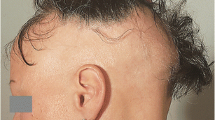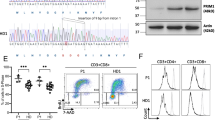Summary
Louis-Bar (L-B) syndrome, also called ataxia-telangiectasia, is cytogenetically characterized by an increased frequency of spontaneous and induced chromosomal aberrations (CA) in cultured lymphocytes and skin fibroblasts. However, it is not yet clear whether the chromosomal instability is also present in uncultured cells. The spontaneous and bleomycin-induced CA in peripheral lymphocytes of 8 L-B patients were evaluated. The micronucleus test was also performed, for the first time in lymphocytes by the cytokinesis-block method, and in uncultured cells of the oral cavity and hair root. The spontaneous frequency of CA and micronuclei in lymphocytes was about 3 times higher in L-B patients than in controls, these two cytogenetic parameters being highly correlated. Moreover, the induction by bleomycin of CA was higher in patients than in controls. The micronuclei in buccal and hair root cells of patients were normal. It remains to be determined whether the different responses obtained with cultured and uncultured cells are the result of the different L-B gene expression of chromosomal instability or whether they arise because of a particular cell sensitivity to culture conditions. The spontaneous and induced CA in lymphocytes of heterozygotes cultured in the presence of L-B serum were studied to evaluate a possible increased sensitivity of heterozygotes to a possible diffusible clastogenic factor present in the plasma of L-B patients. We could not demonstrate the presence of any factor that enhances CA in normal subjects or in heterozygote carriers.
Similar content being viewed by others
References
Aurias A, Dutrillaux B, Buriot D, Lejeune J (1980) High frequencies of inversions and translocations of chromosome 7 and 14 in ataxia telangiectasia. Mutat Res 69:369–374
Bender MA, Rary JM, Kale RP (1985) GO chromosomal radiosensitivity in ataxia telangiectasia lymphocytes. Mutat Res 150:277–282
Chen PC, Lavin MF, Kidson C (1978) Identification of ataxia telangiectasia heterozygotes, a cancer prone population. Nature 274:484–486
Cohen MM, Shaham M, Dagan J, Shmueli E, Kohn G (1975) Cytogenetic investigations in families with ataxia-telangiectasia. Cytogenet Cell Genet 15:338–356
Fenech M, Morley AA (1985) Measurement of micronuclei in lymphocytes. Mutat Res 147:29–36
Fiorilli M, Antonelli A, Russo G, Crescenzi M, Carbonari M, Petrinelli P (1985) Variant of ataxia telangiectasia with low-level radiosensitivity. Hum Genet 70:274–277
German J (1980) Chromosome-breakage syndromes: different genes, different treatments, different cancers. In: Generoso WM, Shelby MD, De Serres FJ (eds) DNA repair and mutagenesis in eucaryotes. (Basic life sciences, vol 15) Plenum Press, New York, pp 429–439
Kohn PH, Kraemer HK, Buchanan JK (1982a) Influence of ataxia telangiectasia gene dosage on bleomycin-induced chromosome breakage and inhibition of replication in human lymphoblastoid cell lines. Exp Cell Res 137:387–395
Kohn PH, Whang-Peng J, Levis MR (1982b) Chromosomal instability in ataxia telangiectasia. Cancer Genet Cytogenet 6:289–302
Littlefield LG, Colyer SP, Joiner EE, Dufrain RJ, Frome E, Cohen MM (1981) Chromosomal radiation sensitivity in ataxia telangiectasia long-term lymphoblastoid cell lines. Cytogenet Cell Genet 31:203–213
Menkes JH (1985) Textbook of child neurology, 3rd edn. Lea & Febiger, Philadelphia, pp 578–588
Nagasawa H, Latt SA, Lalande ME, Little JB (1985) Effects of Xirradiation on cell-cycle progression, induction of chromosomal aberrations and cell killing in ataxia telangiectasia (AT) fibroblasts. Mutat Res 148:71–82
Natarajan AT, Meijers M, Van Zeeland AA, Simons JWIM (1982) Attempts to detect ataxia telangiectasia (AT) heterozygotes by cytogenetical techniques. Cytogenet Cell Genet 33:145–151
Oxford JM, Harnden DG, Parrington JM, Delhanty IDA (1975) Specific chromosome aberrations in ataxia telangiectasia. J Med Genet 12:251–262
Paterson MC, Smith PJ (1979) An inherited human disorder involving hypersensitivity to ionizing radiation and related DNA-damaging chemicals. Annu Rev Genet 13:291–318
Rosin MP, Ochs HD (1986) In vivo chromosomal instability in ataxia-telangiectasia homozygotes and heterozygotes. Hum Genet 74:335–340
Sarto F, Cominato I, Bianchi V, Levis AG (1982) Increased incidence of chromosomal aberrations and sister chromatid exchanges in workers exposed to chromic acid in electroplating factories. Carcinogenesis 3:1011–1016
Sarto F, Finotto S, Giacomelli L, Mazzotti D, Tomanin R, Levis AG (1987) The micronucleus assay in exfoliated cells of the human buccal mucosa. Mutagenesis 2:11–17
Sarto F, Zordan M, Tomanin R, Mazzotti D, Canova A, Cardin EL, Bezze G, Levis AG (1989) Chromosomal alterations in peripheral blood lymphocytes, urinary mutagenicity and excretion of polycyclic aromatic hydrocarbons in six psoriatic patients undergoing coal tar therapy. Carcinogenesis 10:329–334
Shaham M, Becker Y, Cohen MM (1980) A diffusable clastogen factor in ataxia telangiectasia. Cytogenet Cell Genet 27:155–161
Shaham M, Becker Y, Lerer I, Voss R (1983) Increased level of bleomycin-induced chromosome breakage in ataxia telangiectasia skin fibroblasts. Cancer Res 43:4244–4247
Shiloh Y, Tabor E, Becker Y (1982) The response of ataxia-telangiectasia homozygous and heterozygous skin fibroblasts to neocarzinostatin. Carcinogenesis 3:815–820
Stich HF, Rosin MP (1983) Quantitating the synergistic effect of smoking and alcohol consumption with the micronucleus test on human buccal mucosa cells. Int J Cancer 31:305–308
Taylor AMR, Rosney CM, Campbell JB (1979) Unusual sensitivity of ataxia telangiectasia cells to bleomycin. Cancer Res 39:1046–1050
Taylor AMR, Oxford JM, Metcalfe JA (1981) Spontaneous cytogenetic abnormalities in lymphocytes from thirteen patients with ataxia telangiectasia. Int J Cancer 27:311–319
Waldmann TA, Misiti J, Nelson DL, Kraemer KH (1983) Ataxiatelangiectasia: a multisystem hereditary disease with immunodeficiency, impaired organ maturation, X-ray hypersensitivity and a high incidence of neoplasia. NIH Conference. Ann Intern Med 99:367–379
Author information
Authors and Affiliations
Rights and permissions
About this article
Cite this article
Tomanin, R., Sarto, F., Mazzotti, D. et al. Louis-Bar syndrome: spontaneous and induced chromosomal aberrations in lymphocytes and micronuclei in lymphocytes, oral mucosa and hair root cells. Hum Genet 85, 31–38 (1990). https://doi.org/10.1007/BF00276322
Received:
Issue Date:
DOI: https://doi.org/10.1007/BF00276322




